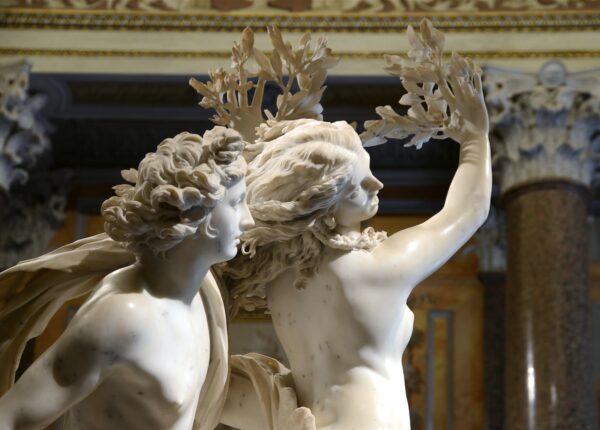
Gian Lorenzo Bernini (1598-1680), Apollo and Daphne, detail of upper portion, 1622-25, marble, 95 5/8 inches (2.43 meters) high, Galleria Borghese, Rome, detail. Photo source: Alvesgaspar / Wikimedia Commons.
Don’t mess with Cupid. Apollo, the most handsome of the Greco-Roman gods, was the charioteer of the Sun, as well as the god of music, poetry, eloquence, art, medicine, prophecy, and archery. But Apollo made the mistake of dissing Cupid — and he paid an everlasting price. This article explores the Apollo and Daphne myth in examples of Renaissance, Baroque, and Rococo art, concluding with Bernini’s extraordinary version.
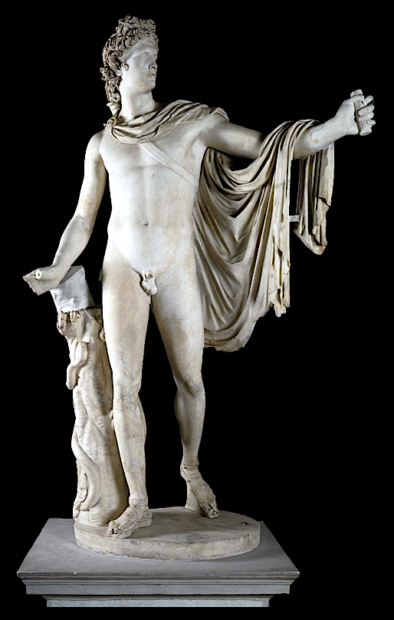
Roman, Apollo Belvedere, probably reign of Hadrian, 117-138, probably a copy of a Greek or Hellenistic bronze, possibly by Leochares from c. 330-320 B.C., marble, 7.3 feet (2.24 meters) high, Vatican Museums, Vatican City. Photo Source: Vatican Museums.
Let us begin with the Apollo Belvedere, a Roman marble likely based on a Greek bronze. Though it was discovered in the late 15th century, the Apollo Belvedere received little attention until it was moved to the Vatican in the early 16th century, where it served as the primary antique reference for images of Apollo and became one of the most influential classical works during the Renaissance. It was even more highly regarded during the Neo-classical period, when it was declared the pinnacle of classical beauty and majesty. (For a short critical history, see entry in The Classical Tradition, 2010.) The statue’s reputation never recovered from this over-valuation, though it is still referenced as a touchstone of male beauty, from the Journal of British Orthodontics to an analysis of People magazine’s “Most Beautiful” people to critiques of longstanding Eurocentric norms.
The statue is generally thought to depict Apollo just after he has shot an arrow, presumably against a mighty foe. Consequently, the statue was originally restored with a bow, as depicted in an ink drawing made when it was in the Belvedere Courtyard (see Laurie Porstner’s article “Restoring ancient sculpture in Baroque Rome,” which also illustrates the Laocoön and a Bernini restoration that are discussed below.) That bow is now removed, though the restored lower right arm and left hand and wrist remain (as in the above illustration). Carol C. Mattusch (“Naming the ‘Classical’ Style,” 2004) reproduces the statue without restorations and raises the possibility that it could be an original Roman creation.
The Belvedere Apollo’s antagonist is most often assumed to be the Python, the first powerful creature that Apollo vanquished. It is part of the story of Apollo and Daphne.
Renaissance and Baroque artists often despaired of equaling the works created by the ancients. The first life size marble nude of the Renaissance, Tullio Lombardo’s Adam, wasn’t made until c. 1490-95. In 1504, Michelangelo met the challenge posed by antiquity with a boldly confident, 17-feet-high statue of David. Like the Apollo Belvedere, which was a primary source of inspiration, David has a tree stump behind its right leg. Because many contemporaries thought the David equaled or exceeded what was then known of classical sculpture, it became a new standard. The Renaissance historian Vasari flatly declared that it was the greatest sculpture ever created. Gian Lorenzo Bernini did not cower before the antique or before Michelangelo. He was determined to create a statue that would both reference and outshine the Apollo Belvedere, but in a novel manner that would astonish his contemporaries. He succeeded. As we shall see, Bernini also interrupted his work on Apollo and Daphne to take direct aim against Michelangelo’s David.

Gian Lorenzo Bernini, Apollo and Daphne, 1622-25, marble, 95 5/8 inches (2.43 meters) high, Galleria Borghese, Rome, triple view. Photo source: kyluc.vn WorldKings.org.
Cupid caused Apollo to become obsessed with the nymph Daphne; he simultaneously made her feel revulsion towards Apollo. The story is beautifully expressed by the Roman poet Ovid (Publius Ovidius Naso, 43 B.C.–17/18 A.D.) in his Metamorphoses, written in 8 A.D. Commencing with the creation of the world, the Metamorphoses treats more than 250 tales of transformation. This poem is our guide to the Apollo and Daphne story. Unless otherwise noted, the translation used here is the Samuel Garth, John Dryden, et al, edition published in 1717. Like many English translations, the 1717 translation rhymes, though Ovid’s text did not. (For a brief discussion and sampling of translations, see Editor Eric.)
Bernini’s Apollo and Daphne is not only the most remarkable treatment of the Apollo and Daphne theme in art, it is the most astonishing marble sculpture in existence. It defied the material’s perceived limitations and served as a manifesto of the Baroque, an age Bernini dominated as a sculptor. Since marble has less tensile strength than bronze, marble copies usually introduce elements to serve as braces. In the Apollo Belvedere, the tree stump on the right of Apollo and the strut under his left foot serve this purpose. Bernini’s dynamic and complex statue seems to deny not just the conventions, constraints, and necessities of marble sculpture, but gravity itself. Most impressively, Apollo and Daphne is carved from a single block of stone (ex uno lapide), a feat for which the Roman historian Pliny the Elder reserved the highest esteem, though Anna Anguissola says it might have functioned as “a conventional form of praise rather than an observation based on reality” (Supports in Roman Marble Sculpture, 2018).
Before focusing on Bernini’s Apollo and Daphne in detail, we will review other treatments of the theme to explore Ovid’s narrative and to consider different ways of telling this story in a single work of art.
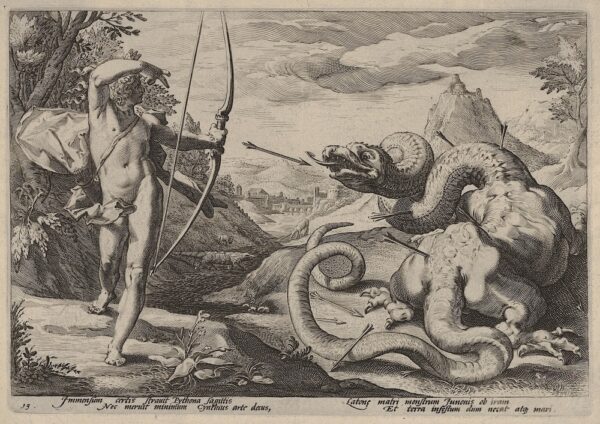
Possibly by Robert Willemsz de Baudous (1574/5–1659) after Hendrick Goltzius (1558–1617), Apollo Killing the Python, 1589, engraving, plate: 6 7/8 x 9 13/16 inches; sheet: 7 9/16 x 10 5/16 inches, Metropolitan Museum of Art, New York. Photo source: Metropolitan Museum of Art.
This engraving, which is after a design by Goltzius, is one of the innumerable works in various media that reflect the Apollo Belvedere. The Python was a monstrous dragon, born from the fertility caused by the great flood at the beginning of the world. The progeny of Gaia, the Greek goddess of the earth (called Terra or Tellus by the Romans), it was enormous. Ovid tells us the earth (Gaia)
… brought to light
Thee, Python too, the wondring world to fright
Python guarded the prophetic stone at Delphi, regarded as the ancient world’s prime oracular site. Apollo ventured to Delphi to kill the Python and to wrest control of Delphi’s oracular powers from Gaia. See: “The Python in Greek Mythology.”
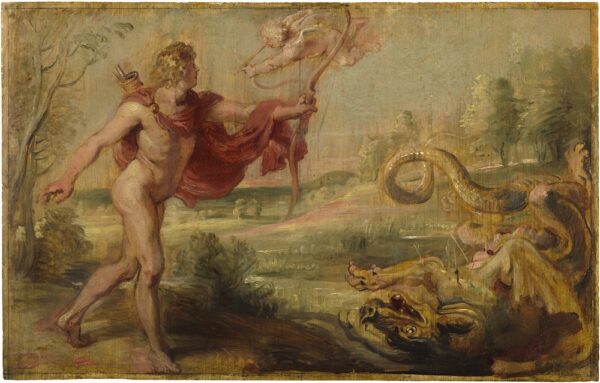
Peter Paul Rubens (1577-1640), Apollo and the Python, c. 1636–37, oil on wood, 27 x 42 cm, sketch for the Torre de la Parada, Prado Museum, Madrid. Photo source: Prado Museum.
In his sketch, Apollo has killed the Python, here represented as a winged dragon (don’t rely on the Prado website, because it confuses the Python with the dragon that threatened Andromeda). Directly above Apollo’s bow, Cupid is shooting the god of archery with an arrow. After his victory over the Python, Apollo instituted the Pythian Games, the second-most important Panhellenic competition after the Olympic Games. As Ovid tells it:
The prize was fame: in witness of renown
An oaken garland did the victor crown.
The laurel was not yet for triumphs born;
But every green alike by Phoebus [Apollo] worn
So, if Apollo instituted games with an “oaken garland” prize to commemorate his victory over the Python, Cupid should have shot Apollo long after he slayed the Python. Be that as it may, the section of Ovid’s poem that treats Daphne is called “The Transformation of Daphne into a Laurel.” It explains that Daphne was “the first and fairest of [Apollo’s] loves,” and how, as a consequence of Cupid’s vengeance, the laurel tree was created and laurel garlands became symbols of victory and fame.
Apollo brags about his strength, marksmanship, and the feat of killing the Python. He mocks Cupid’s erotic fixation and his small stature. Apollo also seems to denigrate love. Ovid tells it this way:
What are you doing with such manly arms,
lascivious boy? That bow befits our brawn,
… we managed to lay low the mighty Python,
whose pestilential belly covered acres!
Content yourself with kindling love affairs
with your wee torch—and don’t claim our glory!
(I use Charles Martin’s 2005 prose translation above, because the 1717 translation lacks clarity on these points.)
We can only imagine how condescendingly Apollo must have laughed off Cupid’s reply:
“… mine the fame shall be
Of all thy conquests, when I conquer thee.”
Cupid shoots Apollo with the gold-tipped arrow of love (pictured in the Rubens above) and he shoots Daphne with the lead-tipped (or possibly a lead-filled or lead-covered) arrow that will make Apollo repugnant to her:
Two diff’rent shafts he from his quiver draws;
One to repel desire, and one to cause.
One shaft is pointed with refulgent gold:
To bribe the love, and make the lover bold:
One blunt, and tipt with lead, whose base allay
Provokes disdain, and drives desire away.
The blunted bolt against the nymph he drest:
But with the sharp transfixt Apollo’s breast.
Bronwen L. Wickkiser notes that Ovid’s Metamorphoses is the earliest surviving Apollo and Daphne text that features Cupid and his alchemical arrows. Cupid, in the earliest surviving Greek myths, had utilized a flame to stoke passion. Cupid’s bow does appear in some Greek tales, but it is more common in Roman literature. Wickkiser points out that Cupid’s gold arrow is “attractive and inducing attraction.” It penetrates all the way to Apollo’s marrow. He also discusses the leaden arrow (unique to Ovid’s version) in the context of ancient magic and medicine, which regarded lead as an anti-aphrodisiac, contraceptive (effective but potentially deadly), and the material of choice for erotic curse tablets (“Cupid’s Arrows: Lead, Gold, Magic and Medicine in Ovid, Met. 1.452-567,” Mnemosyne, 2018).
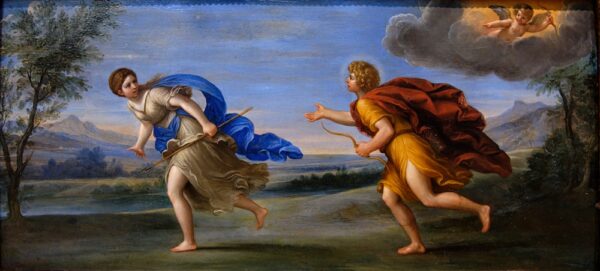
Francesco Albani, Apollo and Daphne, c. 1615-1620, oil on copper mounted on wood, 6.8 x 13.9 inches, Louvre Museum, Paris. Photo source: Louvre Museum / Wikimedia Commons.
The next phase of the story — Apollo’s futile pursuit of Daphne — is here represented in Francesco Albani’s oil painting, which was apparently painted shortly before Bernini made his sculpture. Ovid describes it this way:
Th’ enamour’d deity pursues the chace;
The scornful damsel shuns his loath’d embrace:
While Daphne — thanks to Cupid — loathes Apollo in particular, she, like the virgin huntress Diana, kept a vow of chastity. Also like Diana, Daphne is a huntress, which is why she is depicted with a bow or a spear (she has the latter in the Albani painting). Daphne spurned the numerous men who had pursued her:
By many suitors sought, she mocks their pains,
And still her vow’d virginity maintains.
Impatient of a yoke, the name of bride
She shuns, and hates the joys, she never try’d.
Daphne’s father, the river god Peneus, who wanted grandchildren, reluctantly acceded to her celibacy, though he apparently thought her decision was unnatural. He issued a warning:
The good old sire was soften’d to consent;
But said her wish wou’d prove her punishment:
For so much youth, and so much beauty join’d,
Oppos’d the state, which her desires design’d.
Apollo, misled by his oracle, who had displaced Gaia’s oracle, burned with the erotic passion that he had earlier mocked Cupid for inciting:
The God of light, aspiring to her bed,
Hopes what he seeks, with flattering fancies fed;
And is, by his own oracles, mis-led.
… So burns the God, consuming in desire,
And feeding in his breast a fruitless fire:
W. S. M. Nicoll notes that Ovid enacts a farcical role reversal that parallels that of Minerva and Venus in his Amores: “Cupid, the unwarlike Love god, usurps Apollo’s traditional bow and arrow while the warrior Apollo takes on the role of the archetypal elegiac lover.” (“Cupid, Apollo, and Daphne (Ovid. Met. 1. 452. ff),” The Classical Quarterly, 1980).
Though he was the god of eloquence, flattery got Apollo nowhere:
He praises all he sees, and for the rest
Believes the beauties yet unseen are best:
Swift as the wind, the damsel fled away,
Nor did for these alluring speeches stay:
Apollo even plays the god card, emphasizing his power and clairvoyance, also to no avail:
Perhaps thou know’st not my superior state;
And from that ignorance proceeds thy hate.
Me Claros, Delphi, Tenedos obey;
These hands the Patareian scepter sway.
The King of Gods begot me: what shall be,
Or is, or ever was, in Fate, I see.
Apollo enumerates some of his powers and accomplishments, only to admit that though he is the god of healing, he has no remedy for this affliction:
Alas that fields and forrests can afford.
No remedies to heal their love-sick lord!
To cure the pains of love, no plant avails:
And his own physick, the physician fails.
Apollo’s entreaties cause Daphne to run even faster. No wonder Albani’s Cupid, who inhabits a dark cloud, raises his little bow in one hand and points down to his mischievous handiwork with the other one.

Piero del Pollaiuolo (c. 1441-before 1496), Apollo and Daphne, c. 1470-80, oil and tempera on wood, 29.5 x 20 cm, National Gallery, London. Photo source: National Gallery.
Pollaiuolo rendered a charming version of the next stage of the story, when Daphne becomes a laurel tree. It happens abruptly in this painting. Apollo — still sprinting in his Renaissance garb — grasps the maiden Daphne. But her arms have already sprouted into a pair of mini-trees, and her left leg is shooting leafy roots and becoming a trunk. The chase after a maiden has turned into an impending collision with a sprouting tree. Her free-hanging right leg, which has failed to sprout roots, indicates that Apollo would have carried her away, had she not germinated so quickly. Ironically, its position echoes the “slung leg” motif that often had sexual connotations in the Renaissance. It functions as a final, ironic taunt in this painting, because Apollo will never possess her — at least not in human form.
In this detail, Daphne is looking down at Apollo with implacable calmness, pleased and relieved by the changes that are taking place. The pagan myth has been “converted,” transformed into a courtly, Christian allegory of chastity. Since Daphne’s position is reminiscent of a crucifixion, her serenity might seem a little odd, though it makes sense as an example of cryptic Christian symbolism. Christian conversion and symbolism are rendered explicit in a Coptic textile in the Louvre (c. 6th-7th century), which shows Daphne extending a cross-shaped flower to Apollo as she is encased in a tree. Another reference to Christianity, in the form of a chi-rho pendant, hangs between her breasts. Pollaiuolo’s Daphne is at peace because she has preserved her virginity (virtue). As in many paintings of Daphne (including the Albani, Houasse, and Poussin in this article), she wears a blue gown, like the Virgin Mary. Since her conversion is a Christian triumph, Daphne’s woody components arguably reference the cross, the Christian symbol of everlasting triumph.
Ovid’s emotional tenor was the opposite of Pollaiuolo’s. Ovid compares Daphne to a hare chased by a hound. Apollo closes in on Daphne, even breathing upon her hair:
The nymph grew pale, and in a mortal fright,
Spent with the labour of so long a flight;
And now despairing, cast a mournful look
Upon the streams of her paternal brook;
Oh help, she cry’d, in this extreamest need!
If water Gods are deities indeed:
Gape Earth, and this unhappy wretch intomb;
Or change my form, whence all my sorrows come.
Scarce had she finish’d, when her feet she found
Benumb’d with cold, and fasten’d to the ground:
A filmy rind about her body grows;
Her hair to leaves, her arms extend to boughs:
The nymph is all into a lawrel gone
Fittingly, Pollaiuolo’s Florentine maiden has taken root on local soil: the valley of the Arno, with its winding river, is in the background. One can even make out the glistening Duomo and Campanile of Florence in the museum’s zoomable image (on the level of Apollo’s hands). Pollaiuolo also depicted several tiny hunting scenes. These no doubt reference courtly life in the Renaissance. But they also echo Daphne’s terrifying experience of being “hunted” by the god Apollo, who had compared her flight to a lamb chased by a wolf, a dove pursued by a raptor, and a deer hunted by a lion.
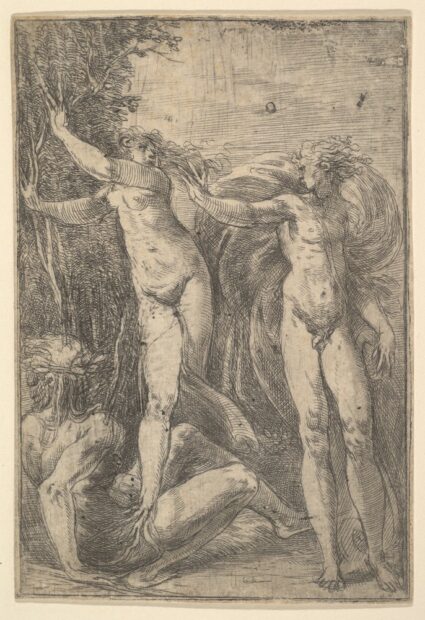
Andrea Meldona, called Schiavone (c. 1510?–1563), Apollo and Daphne, c. 1538-40, etching, 5 ¾ x 3 7/8 inches, Metropolitan Museum of Art, New York. Photo source: Metropolitan Museum.
The strangest depiction of Daphne’s germination is surely in an etching by Schiavone, where she seems to take root directly from Peneus’ body. To use an old Biblical expression, Daphne is the “fruit of his loins.” Upon her return to her native soil, she transforms into a tree that springs almost directly from her father’s loins, the embodiment of the fertile, paternal earth, and of Peneus’ power as a water god. The father’s fecundity has usurped that of mother earth. While neither Apollo nor Daphne is running in this depiction, the chase is referenced by other means: both protagonists have windswept hair, and Apollo has a billowing cloak. In an Apollo and Daphne painting by Schiavone from c. 1542-44 (Kunsthistorisches Museum, Vienna), both of Daphne’s feet are on her father’s body.
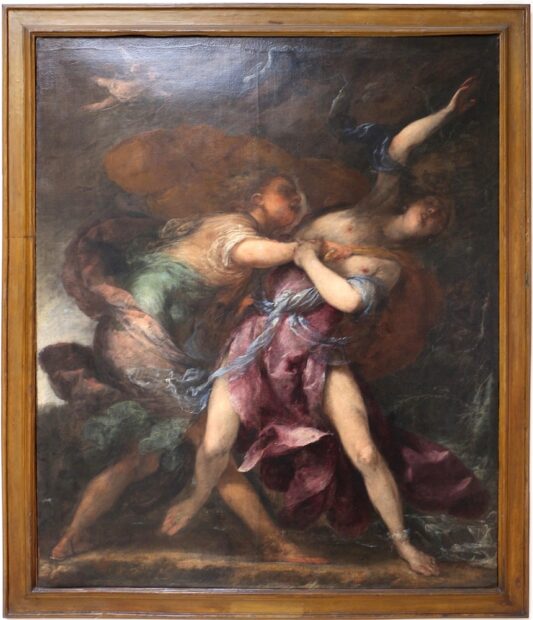
Francesco Montelatici, known as Cecco Bravo (1607-1666), Apollo and Daphne, c. 1650-1660 oil on canvas, 170 x 141.5 cm, Pinacoteca Communale, Ravenna. Photo source: Sailko / Wikimedia Commons.
While Pollaiuolo minimized the threatened violence inherent in the Apollo and Daphne narrative, Cecco Bravo makes violence the core of his painting. As Cupid waves his bow in the heavens, Apollo has descended from the heights of Olympus to the pits of human depravity. He resembles a period ruffian or bandit, and behaves like a common rapist. Apollo twists his body like a wrestler, seemingly trying to gain the leverage necessary to throw Daphne to the ground.
Apollo’s right limbs and body mimic the shape of a sprung bow, as if to penetrate Daphne with his “arrow.” Daphne’s right limbs and body, by contrast, are extended like an undulating un-sprung compound bow (like the kind in the Rubens painting). Apollo’s left leg and Daphne’s body and right arm form a diagonal that extends all the way from the lower left corner of the painting to the upper right. These compositional elements underscore the frenzied struggle.
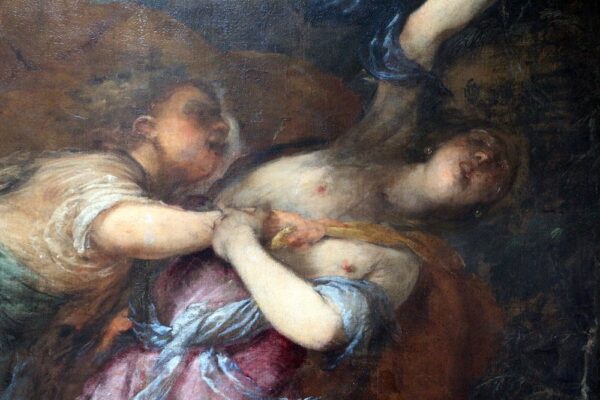
Francesco Montelatici, known as Cecco Bravo, Apollo and Daphne, detail. Photo source: Sailko / Wikimedia Commons.
Apollo appears to be undoing Daphne’s outer garment. As he pulls on a clasp, Daphne fights him off with one hand and extends the other to the sky. Their faces are twisted into grimaces. Laurel leaves appear above Daphne’s head — and not a moment too soon.
Make no mistake: if Apollo had gotten his way, the result would have been a brutal rape — according to modern jurisprudence, since neither Roman nor Baroque legal codes had a directly corresponding legal term (I touch on this issue in a discussion of Artemisia Gentileschi).
Apollo was cruel. After the satyr Marsyas challenged him to a musical contest, Apollo flayed him alive. Rape, moreover, was essentially a godly right or prerogative. Cupid’s flames and arrows are irresistible. Their painful wounds impel, excuse, and normalize rape. In classical myth, rape is essentially portrayed as defensive and necessary for the development of culture or of the natural world. Many transformations in the Metamorphoses take place in order to facilitate rape, rather than to frustrate it.
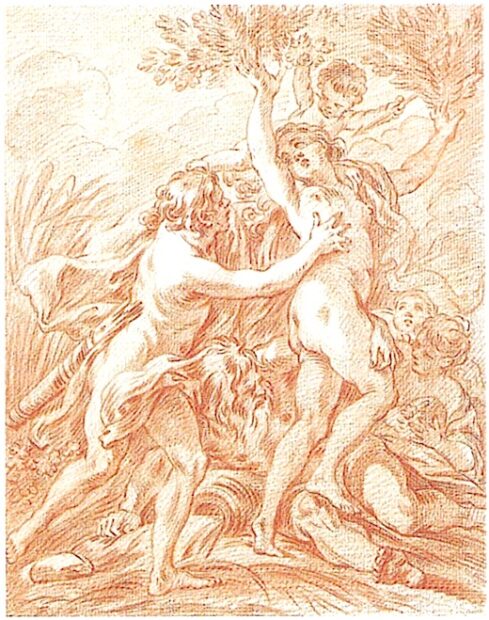
François Boucher (1703–1770), Apollo and Daphne, c. 1730s, 9.9 x 7.7 inches, red chalk on paper, collection unknown, auctioned at Sotheby’s, 1998. Photo source: Sotheby’s.
Even François Boucher, who was often a purveyor of feathery and accommodating Rococo-coquettery, here depicts an unusually robust and confrontational Apollo. Daphne’s right leg rests on her father Peneus’ right leg. Symbolically, she has found sanctuary upon reaching the river, which is the river god’s domain (the point of Schiavone, as well). Peneus grasps Daphne’s right thigh, literally shielding her vulva from Apollo. Apollo has a hand on Daphne’s trunk, but it is too late: her outstretched hands are bursting into branches. If we interpret the water emerging from the jug as the river Peneus, Daphne has already crossed to the other side, while Apollo straddles it. Meanwhile, the putto above Daphne is the ever-triumphant Cupid. He holds an arrow in his left hand, and apparently a sprig of laurel in his right hand. This preemptive appropriation of Apollo’s soon-to-be emblem of victory is ironic, if not inappropriate: Cupid is witnessing and celebrating the victory he predicted over the martial god of prophecy, and that god does not yet realize he has lost. Cupid’s outstretched arms even take the shape of a small bow, the means by which he vanquished and humiliated the boastful god of archery.

René-Antoine Houasse (1645-1710), Apollo Pursuing Daphne, 1677, oil on canvas, 62.2 x 47.6 inches, Château de Versailles. Photo credit: GalleriX / Trzesacz / Wikimedia Commons.
René-Antoine Houasse’s painting likely provided the structure for Boucher’s complex and sophisticated pastel variant discussed above. Daphne’s toes on the water jug (the river Peneus) invoke the power of her water-god father: her right foot germinates roots; branches sprout from her upraised right hand and head. As in the Boucher, Peneus raises his left arm to cover Daphne’s genital region and to block Apollo’s advance. This gesture makes more narrative sense in the Houasse, due to Daphne’s more frontal orientation.

Nicolas Poussin (1594-1665), Apollo and Daphne, 1625, oil on canvas, 38.1 x 51.5 inches, Alte Pinakothek, Munich. Photo source: AlainTruong.com.
As in the Boucher, all four primary protagonists are present in Poussin’s elegiac rendition, which is a meditation on loss. Daphne — the athletic huntress who long eluded Apollo’s pursuit — loses the only life she had known, one explicitly predicated on an unfettered existence free from male control. But the actions of three male gods have imprisoned her. Roots chain her to the earth; she is unable to take so much as a single step. Daphne gazes heavenward, like a bound St. Sebastian who is stuck with twigs instead of arrows. Apollo has lost his first love at the very moment she finally falls within his grasp. He stares longingly while plucking a sprig of laurel. Peneus, who has lost his daughter, mourns with an ancient gesture: he covers his face with his arm.
This brings us to the next part of Ovid’s story (again using Charles Martin’s 2005 prose translation), wherein Daphne continues to reject Apollo:
Loving her still, the god puts his right hand
against the trunk, and even now can feel
her heart as it beats under the new bark;
he hugs her limbs as if they were still human,
and then puts his lips against the wood,
which, even now, is adverse to his kiss.
The only “winner” in Poussin’s painting is the minor god who put this sinister scenario in motion. A corpulent Cupid defies gravity and hovers beside Apollo and Daphne. His drawn bow does not threaten another volley. Rather, it illustrates the beginning of the myth, and it serves as an emblematic sign of Cupid’s vengeful reign of love over the lives of gods and nymphs. The cavorting putti on the left will be replaced by neighboring river gods, who will console Peneus in Ovid’s next story, which treats the transformation of Io. For an illustration of this theme, see River gods consoling Peneus for the Loss of his Daughter, Daphne from “The Story of Apollo and Daphne” by the Master of the Die (active 1530-1560).
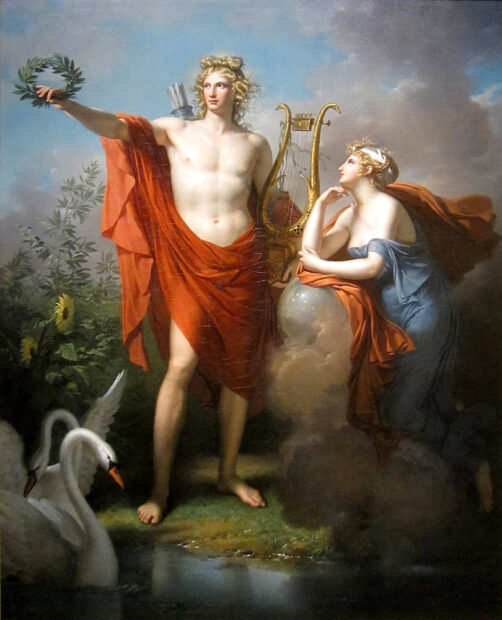
Charles Meynier (1768-1832), Apollo, God of Light, Eloquence, Poetry and the Fine Arts with Urania, Muse of Astronomy, 1798, oil on canvas, 108 ¼ × 92 ½ inches, Cleveland Museum of Art. Photo source: Cleveland Museum of Art.
Ovid concludes this story with Apollo telling Daphne that though she will not be his bride, “you will assuredly be my own tree.” (I use Charles Martin’s translation in this paragraph). Apollo vows to adorn his hair, lyre, and quiver with laurel. He adds that triumphant generals will wear the laurel as well. Apollo promises: “you will be an evergreen forever.” Finally, Ovid’s last line declares: “Laurel shook her branches and seemed to nod her summit in assent.” In this manner, Apollo turned the object of his amorous defeat into an emblem of victory: she would not be his trophy wife, but she will still be his trophy.
Meynier’s figure of Apollo is essentially the Apollo Belvedere statue in reverse. Instead of a bow, he holds a laurel crown in his extended arm, the now-universal symbol of honor. Returning to the Poussin, we can see that Apollo is already wearing a wreath, even before Daphne has finished turning into a tree. Thus Poussin has compressed the entire Ovidian narrative into one painting.
How Bernini Revolutionized Sculpture
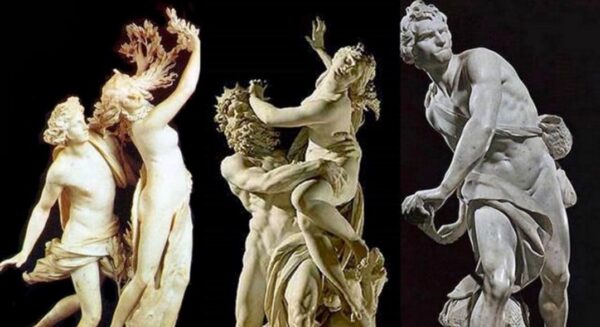
Gian Lorenzo Bernini (1598-1680), Apollo and Daphne (1622-25), Pluto and Proserpina (1621-22); David (1623-24), Galleria Borghese, Rome. Photo source: Quizz Club.
Caravaggio had revolutionized painting by the time he died in 1610, and the corresponding innovation in sculpture was provided by three statues Bernini carved for Cardinal Scipione Borghese: Pluto and Proserpina (1621-22); David (1623-24); and Apollo and Daphne (1622-25). Simon Schama refers to them as “a procession of dumbfounding masterpieces.” As C.D. Dickerson III, then curator of European art at the Kimbell Art Museum, observes in the exhibition catalogue Bernini: Sculpting in Clay (2012), they are “widely considered the high points of Bernini’s entire career — and even of all seventeenth century sculpture.” (Held at the Kimbell and the Metropolitan Museum of Art, the exhibition’s catalogue can be downloaded here.)
In a 2008 book chapter, Michael Cole notes that shortly after he completed these statues, Bernini became the impresario of monumental papal works projects, as well as something akin to an installation artist who created entire environments.
Consequently, these dazzling works that Bernini made in his twenties stand out because he subsequently privileged conception and design over hands-on finish and craft. Bernini’s portrait busts, which include several popes, a king of England and one of France, and the pair of astonishing “speaking likeness” busts of Scipione Borghese, are exceptions to this rule, as is the Blessed Ludovica Albertoni (1674), whose brilliant workmanship betrays Bernini’s skilled hands.
Gian Lorenzo was a prodigy, who, as noted by Dickerson, essentially became a professional partner with his sculptor father Pietro by the time he was an adolescent. Bernini finished his first marble bust around 1612, when he would have been 13 or 14, and he completed a papal bust (of Scipione’s uncle) in 1618. That same year, Bernini was deemed worthy of completing an unfinished Michelangelo sculpture, had Cardinal Maffeo Barberini been able to acquire it. Consequently, while he was creating new potentialities for sculpture in the 1620s, Bernini was already cognizant of his place in history. He was self-consciously vying with exemplars from the classical past, some of which inspired him directly, some of which survived only in written descriptions, and some of which would surround his own sculptures in the Villa Borghese. At the same time, Bernini was competing with Michelangelo, the greatest sculptor of the Renaissance, to whom he would often be compared.
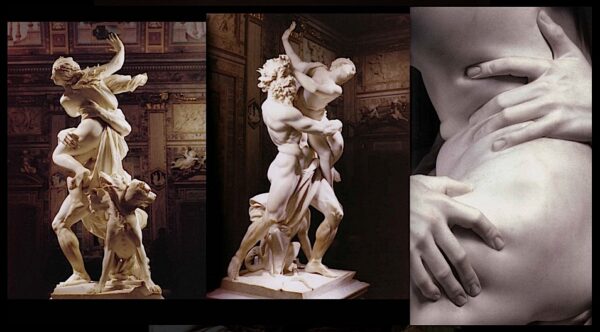
Gian Lorenzo Bernini (1598-1680), Pluto and Proserpina, a.k.a. The Rape of Proserpina, two general views and a detail, 1621-22, marble, 100 1/8 inches (255 cm) high, Galleria Borghese, Rome. Photo source: trudymason.com.
Pluto and Proserpina illustrates another rapist-god scenario from Ovid’s Metamorphoses, one that serves to rationalize the seasons. Bernini’s Herculean Pluto is muscular, like the central figure in the Laocoön, who battles snakes. Of all the classical sculptures available to Bernini, this late Hellenistic work (sometimes termed “Hellenistic Baroque”) likely spoke most powerfully to him, due to its high drama no less than its high quality.
Pluto hoists a struggling Proserpina, creating unprecedented dynamism and psychological strife. Animation, as Schama notes, was Bernini’s gift: “His figures break free from the gravity pull of the pedestal to run, twist, whirl, pant, scream, bark or arch themselves in spasms of intense sensation. Bernini could make marble do things it had never done before.”
Pluto and Proserpina represents a quantum leap over Aeneas, Anchises, and Ascanius (1618-19), the first multi-figure commission Cardinal Borghese awarded to Bernini. Though it is a very fine sculpture, it lacks the jaw-dropping power and originality of the three statues I emphasize in this article. Perhaps the Aeneas is too much like a painting rendered in stone. It has Mannerist echoes, but lacks the supreme grace, refinement, and complexity of the finest Mannerist sculptures. Aeneas is a somewhat tentative first step, in which the young Bernini dispenses with Mannerist artificiality by injecting strong doses of realism, but he has not yet hit upon an equally powerful alternative formula. When Bernini looked at the Laocoön, he must have seen what was lacking in his Aeneas. Pluto and Proserpina is a full-blown burst of Baroque energy, power, conflict, and emotion, rendered palpable by an unprecedented mastery over the surfaces of stone. Proserpina is only the second female Bernini sculpted in marble; Dickerson says the depiction of her distress is “electrifying.”
Bernini’s Rape of Proserpina vies with two eminent classical sculptures that survive only through description. Matthias Winner points out that both Pliny and the Renaissance historian Vasari mention a lost taking of Proserpina by the eminent classical sculptor Praxiteles. Victor M. Schmidt notes that Pliny also wrote of a sculpture by Cephisodotus (Praxiteles’ son) that was famous for the way one figure’s fingers seemed to be grasping flesh rather than marble. Bernini later boasted of treating marble as if it were wax or dough. Clay, of course was his intermediary, and Dickerson argues that clay’s malleability made it the perfect medium to bend and stretch until it yielded the desired form.
In terms of artistry, David isn’t as impressive as Pluto and Proserpina and Apollo and Daphne, though it is a revolutionary composition. The tightly wound David is about to unleash his sling. Consequently, the viewer is put in the position of Goliath—watch out, you know what’s coming! While Caravaggio inserted his self-portrait as a gorily-beheaded Goliath into a painting that is also in the Galleria Borghese, Bernini used his own young face for the figure of David. This gritty, twisted, and rather nondescript young man is the very antithesis of the god-like mammoth that Michelangelo carved for the Florence cathedral.
These three Bernini sculptures still shock and amaze modern viewers, who marvel at exquisite details, and wonder how the hoisted nymph Proserpina and Apollo’s fluttering draperies have managed to defy gravity all these years. Andrea Bacchi, co-curator of the 2008 Bernini exhibition at the Getty and the National Gallery in Ottawa, says of Apollo and Daphne: “In my opinion, not even the ancients did anything to equal it.”
Bernini’s Apollo and Daphne
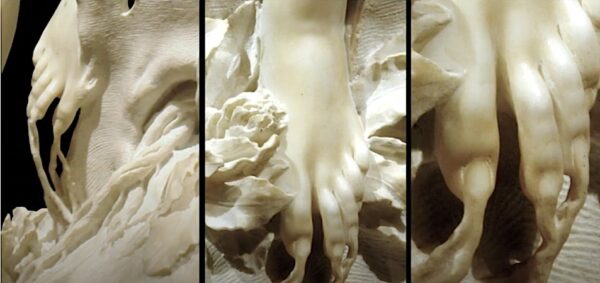
Gian Lorenzo Bernini, Apollo and Daphne, detail: triple view of sprouting feet. Photo source: Apollo and Daphne, Friends of the Villa Borghese video screenshot.
Bernini wanted to express as much of the story as he could with two figures in a large sculpture, instead of including a third figure, like the three-headed dog of Hades that he included in the Pluto and Proserpina. The drapery and dog function as figural struts that help to support Proserpina. Bernini could have used a figure of Peneus in the same manner, but it would have detracted from the clarity and drama of the chase. Compare, for instance a bronze from c. 1700 attributed to François Lespingola (1644-1705), in which Daphne (to be followed by Apollo) hopped over Peneus as if he were a hurdle (see multiple views in the Sotheby’s 2010 auction catalogue). Peneus is fine in a two-dimensional representation of the myth, but he really mucks up a sculpture.
Bernini’s Apollo and Daphne conveys and compresses three quasi-cinematic states: chase, arrest, and transformation. Bernini also implies a fourth state: the speeding young god is about to crash into a tree. Humor is central to Bernini’s poetic conceit, which is dependent upon his ability to render instantaneity. The inherent physicality of stone sculpture (relative to painting) compels the spectator to imagine this fourth state because Apollo’s mass and velocity — as well as Daphne’s transformative state — is rendered in such tangible fashion. Aided by Cupid, Apollo finally caught Daphne with a final burst. We know Daphne is not budging because her feet have taken root and bark is encasing her body. As part of her magical transformation, Daphne — who is already situated on the peak of the rocky base — is impelled skyward, like a wooden figurehead on the prow of a ship. As Schama puts it, “Apollo is thwarted by a lightning metamorphosis as Daphne’s body seems to climb into the sky like the tree she is instantly becoming.” As Apollo grasps her in this marble instant, she is primarily human. By the time he takes his next step, he will have collided with a tree. The viewer, of course, is always a few steps ahead of Apollo.
I am not the first to quote Andrew Marvell’s poem “The Garden” (1681) in connection with this statue, but I do so with a more literal intent:
The gods, that mortal beauty chase,
Still in a tree did end their race

Apollo and Daphne cartoon (signature illegible), from the video Apollo en Daphne, posted by bacchylides on Youtube, 2010. Photo source: screen grab.
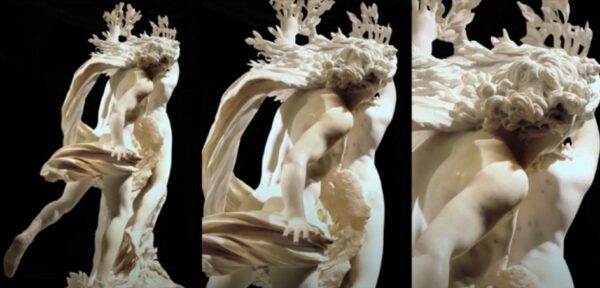
Gian Lorenzo Bernini, Apollo and Daphne, triple rear view. Photo source: Apollo and Daphne, Friends of the Villa Borghese video screenshot.
In addition to its complex and sophisticated narrative, Apollo and Daphne is a marvel of engineering, particularly the figure of Apollo, who has an outstretched right arm, but only one foot on the ground. Compare this to the Apollo Belvedere, who needs a supporting stump and strut to support relatively minimal motion.
Imagine if we could chart the development of Bernini’s statue through a complete array of terracotta models, watercolors, pastels, and drawings. Unfortunately, no models or sketches in any medium survive. By contrast, when the German artist Joachim von Sandrart visited Bernini’s studio (sometime before 1635), he saw 22 models for the statue of St. Longinus (1631-38) now in St. Peter’s Basilica. While this single figure of a centurion is less complex than the Apollo and Daphne, it stands nearly 15 feet high and was carved from multiple blocks. Consequently, we cannot assume that the number of models Bernini fashioned for his Apollo and Daphne were necessarily legion. But I do imagine that he made quite a few. I don’t think Bernini arrived at his final composition quickly, especially since he was in the process of smashing the perceived limitations of stone carving. I envision Bernini gradually pushing the boundaries, trying to imagine and create novel, seemingly impossible effects in marble. The forms that he had conceived on paper were likely recreated in clay. He might even have made models that he thought he could not safely reproduce in marble. Unfortunately, we also lack written accounts of Bernini’s working process during the 1620s.
Dickerson thinks it is likely that Bernini made a presentation model, at least for the Pluto and Proserpina. Such a model, perhaps one or two feet in height, would have been relatively highly finished. If presentation models were made and had survived for the three innovative sculptures discussed here, they would be extremely valuable because impurities in the marble forced the artist to make unanticipated adjustments.
If Bernini had followed the studio practices prevalent at the time, his studies for each sculpture would have culminated in a full-scale clay model. Both Pluto and Proserpina and Apollo and Daphne feature large, projecting forms. Therefore I think it is likely that Bernini made full-scale clay models for these two sculptures. If the elements that support the projecting masses were not plotted precisely, the marble could crack or break. Consider also that the finished statues had to be transported by carts powered by draft animals over the hilly terrain of Rome. Breakage would waste expensive marble and perhaps a year or more of labor. Even worse, it would result in the proud artist’s humiliation, damage to his career, and loss of patronage, which happened with Bernini’s ill-fated towers for St. Peter’s Basilica, which were torn down.
Clay is easy to work and to alter. Moreover, an assistant could carve nearly all of the marble by imitating a full-scale model. Bernini made David during a hiatus from Apollo and Daphne. A full-scale model would have allowed his assistant to do most of the work while he was otherwise engaged. I picture Bernini scampering about with plumb lines, making numerous measurements and geometrical calculations, and even shaking the clay figures to test their stability. Whatever models Bernini and his talented assistant Giuliano Finelli (1601-1653) utilized, they successfully translated them into marble.
The most admired details of Apollo and Daphne — the hair, branches, and leaves — are generally credited to Finelli, though one cannot differentiate the work of separate hands. The leaves are so thin that they are semi-translucent in bright light. I suspect they could have been inspired by ivory sculptures, which can easily be worked to translucent thinness, as can hair and billowing drapery.
Were Finelli’s skills essential for these details? Did he play a creative part in conceptualizing them, or in pushing the boundaries of marble carving? Could Bernini have done just as well without him? There is no firm consensus among art historians. I am inclined to believe that Bernini could carve anything as well as Finelli. But would Bernini have been willing to spend the time necessary to create so much maniacal detail? It makes sense that Bernini — who had an unmatched ability to make his stone faces convey emotion — concentrated on the sculpture’s primary features.
What, exactly, did Bernini intend these faces to convey? Significantly, Daphne is bent backwards. She is straining to look at Apollo, rather than staring at her sprouting hands. Ovid described how she perceived the heaviness of limb and the clinging roots. While we can see the changes that are taking place, Daphne feels them. I believe her expression is intended to convey the contingency of her situation. The fear and desperation of the chase are just starting to turn into something else: the surprise, wonder, and relief of the metamorphosis that constitutes her deliverance from Apollo.
Dickerson describes Apollo’s expression as one of “supreme confidence.” One might add that it is one of extreme overconfidence. Why does he have a godly, relatively blank countenance, even though he is sprinting at maximum speed and even though he is as besotted by Daphne as would be the randiest satyr?
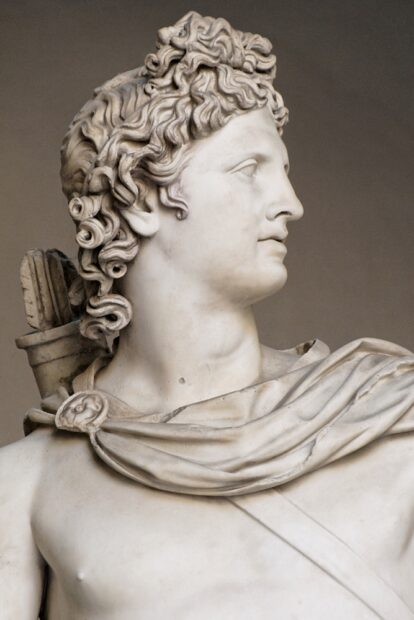
Roman, Apollo Belvedere, detail of head and upper torso. Photo Source: Marie-Lan Nguyen Wikimedia Commons.
Apollo’s facial aloofness parallels that of Bernini’s model, the Apollo Belvedere, which is the quintessential image of godly majesty and ease. As one of the supreme gods, he does not register stress, sexual excitation, the thrill of actually touching his beloved, or shock at her transformation. Like his classical prototype, he has slightly parted lips, which seem to say nothing.
While Daphne perceives what she does not see, Apollo sees but does not perceive. I think Bernini viewed this lack of affect as a defect. Turbulent drapery and twisting strands of hair are compensations that carry the expression that his face lacks.
Neo-classicists loved the Belvedere’s majestic aloofness. It’s hard to imagine that statue chasing anyone, but that is basically what Bernini has done: he’s animated the body, while retaining the impassive face. It wasn’t enough for at least one observer, who complained that Bernini’s Apollo resembled a shepherd more than a god.
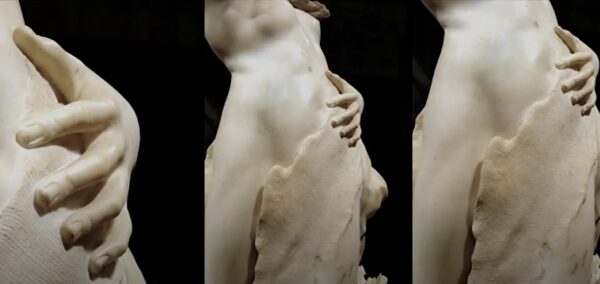
Gian Lorenzo Bernini, Apollo and Daphne, detail: triple view of hand on trunk. Photo source: Apollo and Daphne, Friends of the Villa Borghese video screenshot.
Is there not an element of mocking humor in this Apollonian blankness? The great Apollo, the god of prophecy, appears to have no recognition of what is transpiring with Daphne. Incapable of foreseeing the future, he cannot even comprehend the present. Apollo’s left hand (which is very similar to Pluto’s right hand that digs into Proserpina’s flesh) is on what he assumes is Daphne’s trunk of flesh, but it instead grasps a trunk of bark. Apollo cannot conceive of failure because he does not recognize failure as an option, even when it is staring him in the face. Moreover, he is one step away from a collision with a tree.
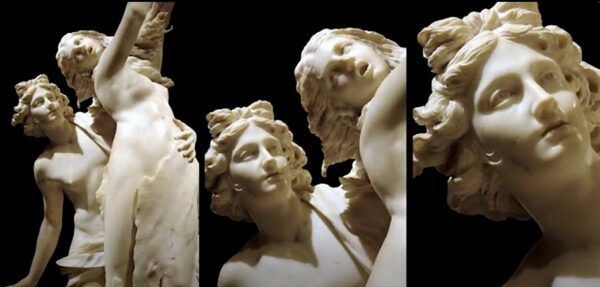
Gian Lorenzo Bernini, Apollo and Daphne, detail: triple view of faces. Photo source: Apollo and Daphne, Friends of the Villa Borghese video screenshot.
Ovid portrays Apollo as a god that is barely capable of outrunning a fleeing nymph. Perhaps we should infer that Bernini’s Apollo — at least in his present state — is rather slow mentally, as well. It has been proposed that Apollo’s outstretched right hand signifies recognition of Daphne’s metamorphosis.
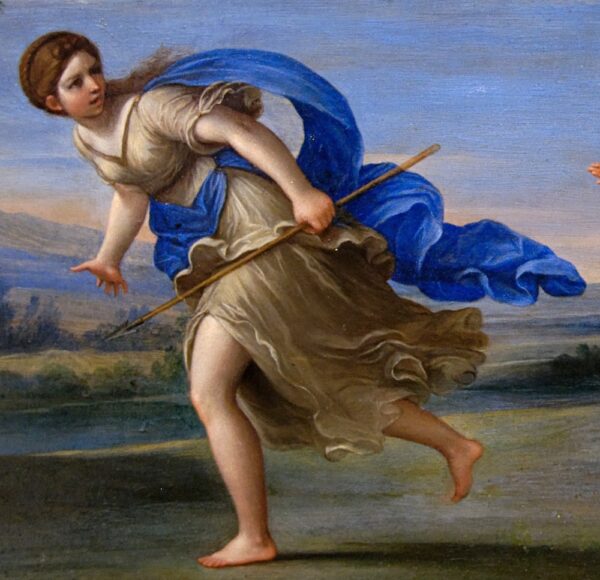
Francesco Albani, Apollo and Daphne, detail of Daphne. Photo source: Louvre Museum / Wikimedia Commons.
But I don’t see it that way, especially since the outstretched hand of Bernini’s Apollo is very similar to that of Albani’s fleeing Daphne. In fact, enough similarities exist to posit a direct connection between the two works. In addition to Daphne’s outstretched hand, both of Albani’s figures have one foot flat on the ground, with the other trailing behind (here Bernini follows the example of Apollo). The billowing drapery behind Albani’s Daphne, which terminates in a dramatic, tongue-like coda, finds an uncanny echo in Apollo’s sculpted drapery. Finally, the painted Daphne looks back at Apollo. This detail, which was not related by Ovid, becomes a powerful interchange in Bernini’s sculpture.

Gian Lorenzo Bernini, Apollo and Daphne, detail: triple view of left side. Photo source: Apollo and Daphne, Friends of the Villa Borghese video screenshot.
The left side of Bernini’s sculpture is the “back” side, intended to be against a wall. Neither face is visible from this perspective, nor is much of Daphne’s body. Frankly, it’s a mess, with tangles of hair that look like mineral deposits. From this side, we can see how solid Daphne’s hair really is, and how it connects with the foliage that sprouts from her hands. The details that are visible from the right side of the statue appear to be impossibly light and fragile, whereas from the left side, it is clear that Bernini has carefully designed solid, interlinking forms that connect and support one another. The fragile-looking details do not spring from thin air, but from a base of solid forms. I assume the artist worked out these intricacies in a full-scale clay model, which would have allowed him to survey these effects from the ground.
When seen from the left, Daphne’s left arm pops up mysteriously out of a hairy chaos. It is humorous, especially given Apollo’s “almost comical fascination” with Daphne’s disheveled hair (Andrea Bolland, “Desiderio and Diletto: Vision, Touch, and the Poetics of Bernini’s Apollo and Daphne,” 2000). Ovid paints a picture of Apollo as a frustrated hairstylist:
Her well-turn’d neck he view’d (her neck was bare)
And on her shoulders her dishevel’d hair;
Oh were it comb’d, said he, with what a grace
Wou’d every waving curl become her face!
The left side of Apollo and Daphne is carved out, and not left blank, though it is more roughly finished, and, as Cole notes, the struts near the tips of Daphne’s fingers were never eliminated. Bernini even put in a punning reference to the Apollo Belvedere (and presumably to Michelangelo’s David, as well): the slender stump appears to have been appropriated from it. It is completely unnecessary. The trunk that is encircling Daphne essentially serves as a giant supporting strut, which allows her legs and feet to dangle freely. At the same time, this large trunk is a critical part of the narrative. It is Bernini’s way of saying “If you need a stump to support your figure, this is the way to do it.” As a gratuitous citation, the Apollo Belvedere-like stump serves as criticism. Bernini had already utilized a tree/strut as part of a narrative in his Bacchanal: A Faun Teased by Children, c. 1616-17 (Metropolitan Museum of Art). The tree supports a faun, a panther, and three putti. The faun climbs it so energetically that his left knee is almost as high as his sternum and a fruit-laden branch is snapped by his right hand. Bernini created varied textures for this sculpture, using a toothed tool for wood grain and the panther’s fur. His bravura rendering of textures reached a new level of mastery in Apollo and Daphne.

Gian Lorenzo Bernini, Apollo and Daphne, detail of feet, plants, ground, tree and rocks. Photo source: Fine Art America.
Apollo and Daphne was resituated to the center of a gallery in 1785, where visitors can walk around it and savor every twist and turn. The left side also provides an informative view of Apollo’s extraordinary drapery, which would otherwise be mysterious. It is, of course, a very animated version of the Apollo Belvedere’s cloak, which Bernini has elongated and put through the wringer. It is as if the biggest snake in the Laocoön has escaped, become a mighty python, and draped himself around Apollo. One end of it rests against the left side of Daphne’s trunk. It winds around Apollo’s left arm, passes over his left shoulder, and unfurls gloriously like a flying buttress of fabric. Then it passes across his groin and right hip and waves behind Apollo like a corkscrewing flame. It serves to stabilize Apollo by binding him more firmly to Daphne at his left arm, which is essentially a strut that welds and supports both the forward-leaning Apollo, and the backward-twisting Daphne. This drapery amplifies Apollo’s strut of an arm. At the same time, above Apollo’s shoulder, this drapery connects to — and reinforces — Daphne’s hair. The drapery behind Apollo’s back rises like a great wave, and Daphne’s hair cascades and lifts off from this drapery like foamy spray cast off from a crashing wave. Bernini gets considerable mileage out of the only article of clothing either figure possesses, and it both connects and supports both figures at several critical junctures.

Gian Lorenzo Bernini, Apollo and Daphne, detail of Apollo from the rear. Photo source: Apollo and Daphne, Friends of the Villa Borghese video screenshot.
Bernini’s dramatic, corkscrewing drapery terminates in a central void, a veritable eye of a fabric storm. Is it mere coincidence that this void virtually replicates the anus at roughly the position of Apollo’s anus? And is it coincidence that the laurel leaves beneath Apollo’s drapery seem to tickle his genital region while they also serve as obscuring fig leaves?
This dramatic drapery takes on more significance if Apollo and Daphne, as it was originally situated in the Villa Borghese, was seen from behind as visitors entered the room (see: Joy Kenseth, in “Bernini’s Borghese Sculptures: Another View” (Art Bulletin, 1981). Kenseth points out that though Bernini’s three innovative sculptures discussed in this article were originally placed against a wall, that does not mean the artist intended them to be viewed from one single “ideal viewpoint.” The story was instead disclosed gradually, as the artist walked around the sculpture, which Kenseth calls “an especially faithful visualization of Ovid’s fable.” Kenseth adds that by “requiring us to be related both physically and temporally to his unfolding dramas, Bernini makes us witness not to ‘picture-like’ forms but, rather, to marvelous performances.” As I suggested earlier, it seems more like a film sequence than a single still or snapshot, with the viewer as a mobile camera.
Another apparent in-joke is that as Apollo pursues Daphne, he runs into her bush.
Actually, a very solid hunk of marble beneath Apollo’s drapery connects his groin area to Daphne’s trunk. The leaves and branches carved around its exterior disguise its mass, especially on the right side (this leafy disguise is more half-hearted on the left side). The museum usually forbids the filming of sculptures, but one called Villa Borghese 1, posted in 2011, has tracking shots (at 1:40, 1:57, and 2:22) of this area of the sculpture that enable one to grasp the massiveness of this disguised strut, especially from below. A video posted by zimbiano in 2013 features three tracking shots of this sprouting strut, primarily from above (at 0:56 from the front, and 1:13 and 1:50), from the left side of the statue.
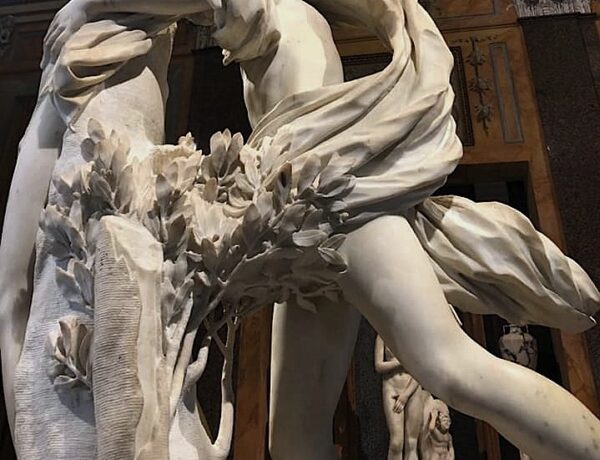
Gian Lorenzo Bernini, Apollo and Daphne, detail of disguised strut from left side. Photo source: Wil Ruggiero.
This large and vegetative Apollo’s-groin-to-Daphne’s-trunk strut is essentially phallic. It reminds me — ironically, because Apollo is out of time — of a couplet from Marvell’s “To His Coy Mistress”:
My vegetable love should grow
Vaster than empires, and more slow.
This strut’s size, permanence, and the fact that it is surrounded by vegetation link it to a particular ithyphallic creature: the minor fertility god known as Priapus.

Pietro Bernini (1562–1629) and Gian Lorenzo Bernini (1598–1680), Autumn in the Guise of Priapus (one of a pair) detail, 1616–17, marble, 89 5/8 × 30 5/8 × 27 5/8 inches, Metropolitan Museum of Art, New York. Photo source: Metropolitan Museum.
Coincidentally, just a few years earlier, Gian Lorenzo had helped his father carve an allegorical figure of a leering Priapus for Scipione Borghese. It (and a female counterpart) originally graced the entrance to the Borghese gardens. The young Bernini contributed the robustly carved fruit, which, with its pronounced solids and voids, emanates a sexual character. As a term statue, it follows ancient tradition. Such statues have an abstract, columnar lower body, except for feet, and, on male statues, an erect penis. Among other things, Priapus was the protector of fruit and male genitals. In this example by the two Berninis, the fruit (another emblem of fertility) obscures the male member.
When Bernini equipped his Apollo with a strut that has a phallic aspect and that is disguised by vegetation (Daphne’s “bush”), he was making an in-joke, one that also referenced Autumn in the Guise of Priapus.
Scipione Borghese as Patron

Louis Gabriel Blanchet (1705–1772), The Sleeping (Borghese) Hermaphrodite, c. 1765, oil on canvas, 72.5 x 97 cm, National Trust, Saltram, U.K. Photo Source: National Trust. Blanchet painted this statue in the Louvre. According to the National Trust, “this is one of a set of eight paintings of celebrated ancient Greek statuary [it is a Roman copy of a late Hellenistic original from the 2nd century B.C.] painted in grisaille (a grey-green monochrome colour) by the artist.”
I asked C. D. Dickerson, now curator and head of sculpture and decorative arts at the National Gallery of Art in Washington, how the commissions for these sculptures with pagan subject matter might have been conceived. He replied: “Bernini was surely relying on the input of the poets and scholars who were friends of his patron, which included the future Pope Urban VIII (then Cardinal Maffeo Barberini). Once an appropriate classical theme had been chosen for the sculptor, Bernini may have discussed with members of this group how best to translate it into stone.”
Members of this circle served as a conduit of classical learning. They must have regaled Bernini with stories of Praxiteles, whose reputation was so great that his lost statues were still being discussed almost two thousand years after his death. This challenged Bernini to up his game in order to achieve a comparable level of fame that would resound through the centuries. This motivation helps account for the perfected beauty and the uncanny naturalism he achieved in the Pluto and Proserpina. No doubt someone told Bernini about Cephisodotus, and his flesh-like marble that seemed to yield to the touch, an effect he recreated in his rendering of Pluto’s hands pressing into Proserpina’s flesh. In this context, the gesture carries the implication of sexual violation: Proserpina’s flesh has already yielded, even when she herself has not. By contrast, Anchises’ old, sagging flesh does not yield to Aeneas’ hands in the same manner. Aenaes, of course, transports his father in order to save him, not to ravish him. Thus an illusionistic technical effect inspired by an unseen ancient statue is made into a bearer of symbolic meaning in what would become the first great monument of Baroque sculpture. This obsession with classical beauty and perfection is also exemplified in Apollo and Daphne, though it does not extend to Bernini’s figure of David. In comparison, he is an urchin with moxie, and perhaps a bit of a rube, with truly unimpressive hair. He is quite unlike Bernini’s Borghese gods. This determined ordinariness must be a response to Caravaggio’s similarly unidealized David.
Haskell terms Scipione’s villa the “delizia di Roma,” a “fantastic confectionary” at “the center of the most hedonistic society that Rome had known since the Renaissance.” He credits the cardinal with the biggest role in a host of stylistic preferences that emerged during Paul V’s pontificate (1605-1621).
As ruthless as he was voracious, Scipione, as the favored papal nephew, built palaces he raced to fill, since much of the family’s wealth and power, which was born with the papacy, would die with his uncle. Scipione imprisoned two artists in order to confiscate paintings; he bought a collection he never paid for; and one Borghese or another even had a Raphael altarpiece stolen from a church in Perugia. The cardinal could also be a generous patron and protector. He commissioned Gian Lorenzo’s first papal bust in 1617 (Paul V), around the time the young artist was helping his father with garden sculptures (the term sculpture discussed above is one of a pair commissioned in 1616 that are in the Metropolitan Museum of Art). He also bought or commissioned other works from Bernini that are not mentioned in this article.
In 1619, Cardinal Borghese hired Bernini to carve the mattress for his prized statue of a hermaphrodite now in the Louvre (also discussed in the Porstner article linked above). With respect to theatricality — and in particular — with the experience of concealment and gradual disclosure discussed by Kenseth, The Sleeping Hermaphrodite must have taught Bernini valuable lessons. While it appears to be a languid and voluptuous female from behind, when the visitor walks around to the other side, s/he discovers that the sculpture has female breasts, but male genitals. The theatricality of this and other late Hellenistic sculptures (such as the Laocoön) provided instructive precedents for Bernini’s Baroque theatricality.
Apollo and Daphne’s sexually punning features were made for Cardinal Borghese’s amusement. They likely also coincided with Bernini’s taste. The eroticism and theatricality in Apollo and Daphne pre-figure those qualities in Bernini’s Ecstasy of St. Teresa in the Cornaro chapel of Santa Maria Victoria (1647-52). See smarthistory and Simon Schama.
Bolland reads Apollo and Daphne and Ecstasy of St. Teresa as structural inversions: the former is “frustrated erotic love… spiritualized through its transformation into the art of poetry,” whereas the latter is “spiritual love… translated… into the physical language of Eros.”
Conclusion
Bernini was not immune from the vicissitudes of taste. He always had his detractors, especially Victorians, papist-haters, and Neo-classicists. But since its creation, Apollo and Daphne has been one of the Villa Borghese’s star attractions, even when the family owned the world’s greatest private collection of antiquities. Napoleon contracted to purchase 695 of these sculptures (including some important ones that had belonged to Scipione) in 1807 for 13 million francs. Though neither the statues nor the money were completely delivered, this purchase formed the core of the Louvre Museum’s classical collection.
Apollo and Daphne was made for a highly appreciative patron who was able to single-handedly sponsor Bernini’s revolution in sculpture in the early 1620s, even though Scipione’s fortunes collapsed catastrophically in 1621, when Paul V died. Haskall overstates his case when he claims that “everyone,” from cardinals to “artists, retainers, and sycophants” deserted him. Bernini surely did not desert Scipione, and his most important sculptures were made after the pope’s death. Moreover, as noted above, they were not commissioned or carved in a vacuum.
Franco Mormando, author of a sensationalistic biography of Bernini in 2011 (the first in English), even maintains that Ludovico Ludovisi, the favored cardinal nephew of the new pope, Gregory XV, was Scipione’s “nemesis” and posed a threat to his life. This, too, seems to be an exaggeration. But for whatever reasons, Scipione made the phenomenal gesture of gifting Bernini’s Pluto and Proserpina to Ludovico in 1622, after possessing it for as little as a month. Both cardinals appreciated that the artistic value of this statue was so great that it could hardly be measured in money.
Scipione might have regretted this gift, since the Ludovisi papacy was almost as brief as a wisp of conclave smoke (two and one-half years), and it was followed by a friendly and familiar Barberini. Bernini sculpted several portraits for the Ludovisi, he restored their most prized antiquity (see the Porstner article linked above), and he was rewarded with a knighthood for his service. The Italian state purchased Pluto and Proserpina and returned it to the Villa Borghese in 1908.
Maffeo Barberini, who became Pope Urban VIII in 1623, transformed Rome in partnership with Bernini. Maffeo had long employed Pietro Bernini, assisted by Gian Lorenzo. Early biographies (one written by Gian Lorenzo’s son) claim that Barberini mentored and lauded Bernini when he was eight years old. In 1617, he commissioned a St. Sebastian (Thyssen-Bornemisza Museum, Madrid) carved by Gian Lorenzo; a 1618 Barberini contract is the first to refer to the young artist by name. When Barberini assumed the papacy, Bernini became his highly favored sculptor-architect-designer. Within a year, Bernini was at work on the Baldacchino for St. Peter’s; by 1629 he was its chief architect. According to Haskell, “it is doubtful whether the relationship between an artist and his patrons has ever been more fruitful.”
The three transformative Bernini sculptures discussed in this article were steeped in ancient literature and famous art. At the same time, they were also daring, innovative, and contemporary. Bernini proved that he could make images that dazzled visually, told a story with high drama, and aroused powerful sentiments. These acclaimed statues had qualities the church was seeking, and they helped propel Bernini on his path to become the chief visual propagandist of the Counter-Reformation, and the single most important creator of Baroque Rome.
Art historians in the Panofskian tradition usually seek close connections between specific texts and artworks, often as if the latter were merely illustrations for the former. But for great artists, any text — even a magnificent one by Ovid — is merely a springboard. Like Ovid and the poets who followed him, Bernini authored his own texts. But his are writ in stone, in three dimensions, and subject to the laws of physics rather than the rules of grammar.
I need only close my eyes to be transported back, across time, space, and quarantine, to the moment I first encountered this sublime crystalline poetry, in the Eternal City, within the magnificent book of Bernini, at home in the Villa Borghese.
The second part of this essay, “Cupid’s Revenge 2: Apollo and Daphne from Ancient Greece to Airbrushed Fantasy,” will appear on Valentine’s Day.
****
My thanks to the following scholars: C. D. Dickerson III and John Herrmann read and commented on a draft of this article; Marino Barberio provided a quality image and date for the Boucher; Matteo Bellucci provided the date and dimensions of the Cecco Bravo.
****
My formal study of Bernini is limited to a survey class taken at Brown University. This article is dedicated to Jody Zeigler, my enthusiastic T.A. for that class. Zeigler was a professor at the College of the Holy Cross until her passing in Nov. 2020.
****
Ruben C. Cordova is an art historian and curator. Apollo and Daphne is his favorite European sculpture.



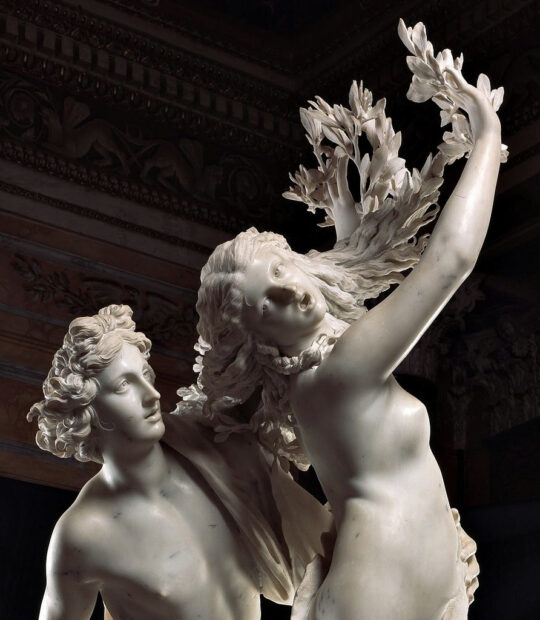
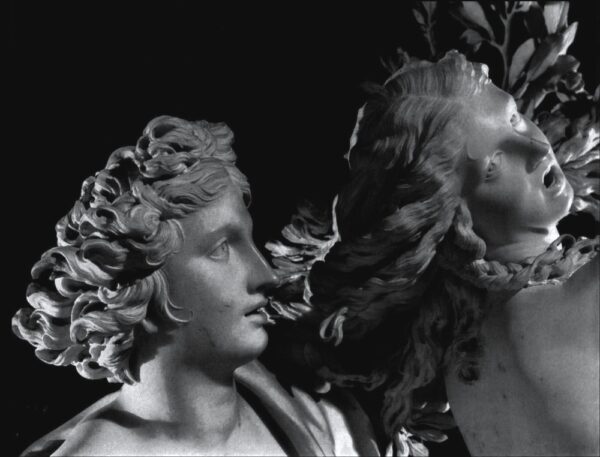

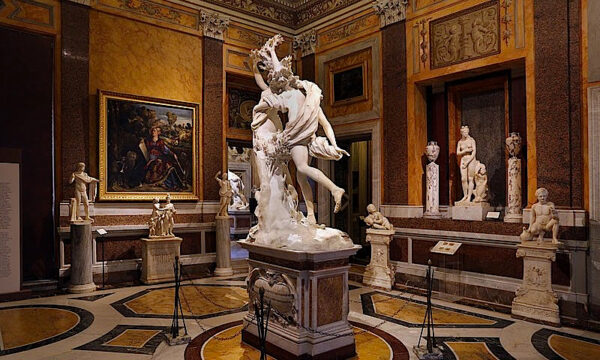

6 comments
Thank you, Ruben Cordova, for a well-written and researched article on Ovid’s Apollo and Daphne story. I was raised with stories from the Greek and Roman myths, and later studied Latin and Greek at the University of Texas. I was in my teens when I saw Bernini’s statue of Apollo and Daphne in person and it affected me profoundly. I agree with you that it is “the most astonishing marble sculpture in existence.” Carrie Tiemann, Tiemann Art Gallery, Round Rock, Texas
Thank you, Ruben, for your amazing–and readable–scholarship.
You are welcome, Carrie. I am glad that you enjoyed the article, and that you had the opportunity to see this amazing sculpture in person.
You are most welcome, Dan. I hope you will also enjoy Part 2, which has some very complex twists and turns.
Great piece Ruben! Time for a book of your writings.
Thanks, Roberto. I might need a couple at the rate I am going.